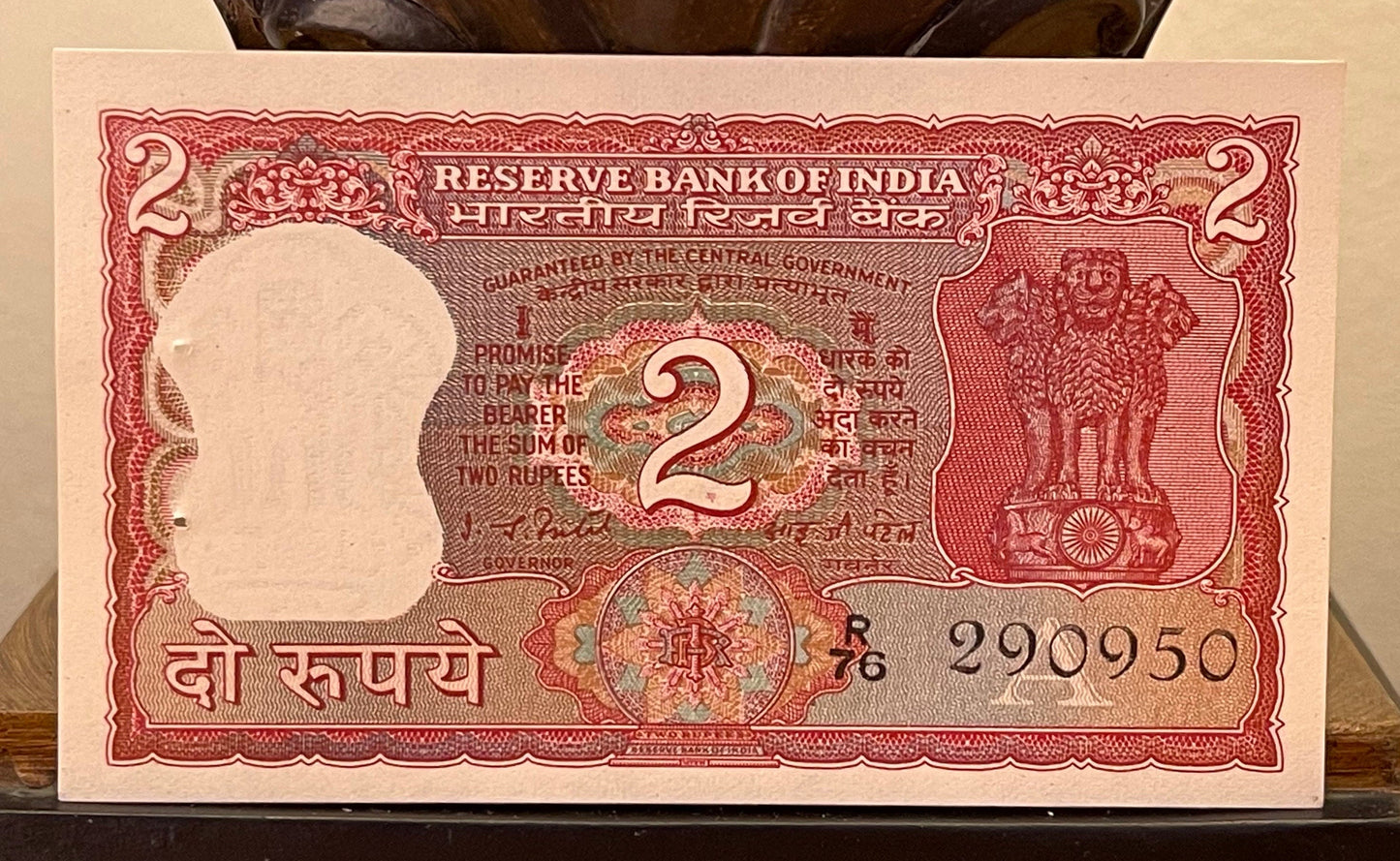elemintalshop
Royal Bengal Tiger & Ashoka Lion Capitol 2 Rupees India Authentic Banknote Money for Jewelry and Crafts Making (Watermark)
Royal Bengal Tiger & Ashoka Lion Capitol 2 Rupees India Authentic Banknote Money for Jewelry and Crafts Making (Watermark)
Couldn't load pickup availability
Royal Bengal Tiger & Ashoka Lion Capitol 2 Rupees India Authentic Banknote Money for Jewelry and Crafts Making
Reverse: Bengal Tiger, the National Animal of India, with 13 regional languages on the back. Urdu in the regional languages being corrected. Circular Reserve Bank of India monogram moving towards the center.
Lettering: BHARATEEYA RESERVE BANK
DO ROOPAYE
TWO RUPEES
Translation: Reserve Bank of India
Two Rupees
Two Rupees
Watermark: Lion Capitol of Ashoka.
Obverse: Lion Capitol of Ashoka. Dark Pink color. Re drawn design
Lettering: BHARATEEYA RESERVE BANK
RESERVE BANK OF INDIA
KENDRIYA CIRCAR DWARA PRATYABHOOT
GUARANTEED BY THE CENTRAL GOVERNMENT
MY/I
DHAARAK KO/PROMISE
DO ROOPAYE/TO PAY THE
ADAA KARNE/BEARER
KAA VACHAN/THE SUM OF
DETAA HUM/TWO RUPEES
2
(SIGNATURE IN HINDI/ENGLISH)
GOVERNOR IN HINDI/ENGLISH
DO ROOPAYE
TWO RUPEES
RESERVE BANK OF INDIA
Translation: Reserve Bank of India
Reserve Bank of India
Guaranteed by the Central Government
Guaranteed by the Central Government
I promise to pay the bearer the sum of Two Rupees
I promise to pay the bearer the sum of Two Rupees
2
Governor
Two Rupees
Two Rupees
Reserve Bank of India
Features
Issuer India
Period Republic (1950-date)
Type Standard banknote
Years 1970-1985
Value 2 Rupees
2 INR = 0.027 USD
Currency Rupee (decimalized, 1957-date)
Composition Paper
Size 107 × 63 mm
Shape Rectangular
Number N# 202692
References P# 53
Wikipedia:
The Bengal tiger, also known as the Royal Bengal tiger, is a tiger from a specific population of the Panthera tigris tigris subspecies that is native to the Indian subcontinent. It is threatened by poaching, loss, and fragmentation of habitat, and was estimated at comprising fewer than 2,500 wild individuals by 2011. None of the Tiger Conservation Landscapes within its range is considered large enough to support an effective population of more than 250 adult individuals. India's tiger population was estimated at 2,603–3,346 individuals by 2018. Around 300–500 tigers are estimated in Bangladesh, 220–274 tigers in Nepal and 103 tigers in Bhutan.
The tiger is estimated to be present in the Indian subcontinent since the Late Pleistocene, for about 12,000 to 16,500 years.
The Bengal tiger ranks among the biggest wild cats alive today. It is considered to belong to the world's charismatic megafauna.
The tiger is one of the animals displayed on the Pashupati seal of the Indus Valley Civilisation. The tiger crest is the emblem on the Chola coins. The seals of several Chola copper coins show the tiger, the Pandya emblem fish and the Chera emblem bow, indicating that the Cholas had achieved political supremacy over the latter two dynasties. Gold coins found in Kavilayadavalli in the Nellore district of Andhra Pradesh have motifs of the tiger, bow and some indistinct marks.
Today, the tiger is the national animal of India. Bangladeshi banknotes feature a tiger. The political party Muslim League of Pakistan uses the tiger as its election symbol. Tipu Sultan, who ruled Mysore in late 18th-century India, was also a great admirer of the animal. The famed 18th-century automaton, Tipu's Tiger was also created for him. The tiger was the dynastic symbol of this dynasty. The iconography persisted and during the Indian Rebellion of 1857, Punch ran a political cartoon showing the Indian rebels as a tiger, attacking a victim, being defeated by the British forces shown by the larger figure of a lion.
Several people were nicknamed Tiger or Bengal Tiger. Bengali revolutionary Jatindranath Mukherjee was called Bagha Jatin (Bengali for Tiger Jatin). Educator Sir Ashutosh Mukherjee was often called the "Tiger of Bengal".
*********
Wikipedia:
The Lion Capital of Ashoka is a sculpture of four Asiatic lions standing back to back, on an elaborate base that includes other animals. A graphic representation of it was adopted as the official Emblem of India in 1950. It was originally placed on the top of the Ashoka pillar at the important Buddhist site of Sarnath by the Emperor Ashoka, in about 250 BCE during his rule over the Maurya Empire. The pillar, sometimes called the Aśoka Column, is still in its original location, but the Lion Capital is now in the Sarnath Museum, in the state of Uttar Pradesh, India. Standing 2.15 metres (7 feet) high including the base, it is more elaborate than the other very similar surviving capitals of the pillars of Ashoka bearing the Edicts of Ashoka that were placed throughout India several of which feature single animals at the top; one other damaged group of four lions survives, at Sanchi.
The capital is carved out of a single block of polished sandstone, and was always a separate piece from the column itself. It features four Asiatic Lions standing back to back. They are mounted on an abacus with a frieze carrying sculptures in high relief of an elephant, a galloping horse, a bull, and a lion, separated by intervening spoked chariot-wheels. The whole sits upon a bell-shaped lotus. The capital was originally crowned by a 'Wheel of Dharma' (Dharmachakra popularly known in India as the "Ashoka Chakra"), with 32 spokes, of which a few fragments were found on the site. A 13th-century replica of the Sarnath pillar and capital in Wat Umong near Chiang Mai, Thailand built by King Mangrai, preserves its crowning Ashoka Chakra or Dharmachakra. The wheel on the capital, below the lions, is the model for the one in the flag of India.jai hind
Share










Royal Bengal Tiger & Ashoka Lion Capitol 2 Rupees India Authentic Banknote Money for Jewelry and Crafts Making (Watermark)









